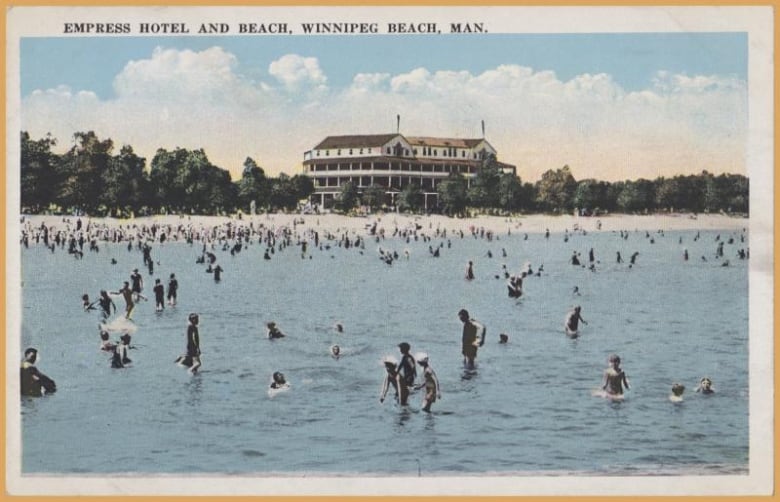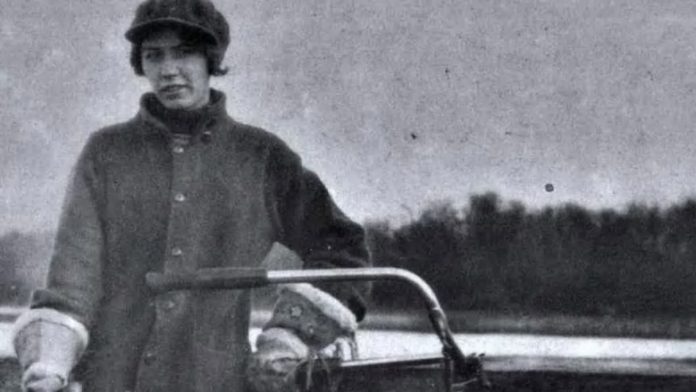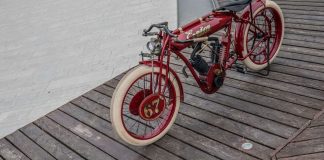She faced long odds, from swampy and rutted terrain to skepticism in a male-dominated era, but Sadie Grimm had something that trumped it all: grit.
In 1914, she did something on a motorcycle that men attempted but failed — she became the first to complete an endurance race from Winnipeg to Winnipeg Beach, across roadless marshlands.
Then the 19-year-old did it again. On the same day.
“She was a pistol, is what her grandchildren called her,” said Ross Metcalfe, a Manitoban who is president of the Antique Motorcycle Club of America and co-founder of the Antique Motorcycle Club of Manitoba.
“I call her plucky. This was something that a very phenomenal woman did 105 years ago, and she showed no fear in being able to do it.”

It was the first documented award in Canadian motorcycling by a woman in a competition also open to men, said Metcalfe.
“Think about the year she did it — it’s 1914, the year Nellie McClung is staging the mock parliament and pushing the government for the women’s vote. So it’s a pivotal time for women and here’s Sadie doing something no man could do,” he said.
“By our record, she’s probably the first woman in North America to win a medal or a trophy or an accomplishment on a motorcycle — and was actually able to keep it.”

A few years earlier, American Clara Wagner won a race between Indianapolis and Chicago but was denied the trophy because of her gender, Metcalfe said.
Race to resort town
The Winnipeg-to-Winnipeg Beach contest, open to anyone, was announced by the Manitoba Motorcycle Club in the winter of 1913-14.
A gold medal was offered up to the first person to complete the 90-kilometre one-way trek from the city to the Empress Hotel on the shore of the popular beach town.
“Winnipeg Beach was Manitoba’s Riviera, it was was Manitoba’s Fort Lauderdale,” said Metcalfe. “It had a huge CPR four-storey hotel with balconies and it was a destination.”

But there were no roads to it. Winnipeg Beach was founded as a resort town in 1900 by the Canadian Pacific Railway, which had the only way to get there.
“The CPR once said that was the most profitable 60 miles of track in all of Canada. Upwards of 13 trains a day would take travellers to the beach and its boardwalk and the fancy hotel,” said Metcalfe.
There were cottages, a dance pavilion, a large pier, water chutes (precursors to modern water slides), and weekend boat regattas that drew as many as 10,000, according to Heritage Manitoba.

“So motorists by 1911-12, they kind of started pointing fingers about the railroad having a monopoly to a place that we want to get to,” Metcalfe said.
So the endurance race was born and motorcycles were a natural choice. Manitoba was a hotbed for motorcycle riding and racing at the time, said Metcalfe.
“There were very many famous racers — men racers — here in Manitoba that were … setting world records,” he said, noting Joe Baribeau, who set a world record at the Kirkfield Park track in 1911 as the fastest man, averaging 60 miles per hour (nearly 100 km/h) over a distance of 100 miles (just over 160 kilometres).
“The first person on Earth to do that and it was done here in Winnipeg. Because of these people being so famous and the Manitoba Motorcycle Club being so dominant, the Canadian Motorcycle Association … moved the Canadian championships to Manitoba in 1914.”

The Manitoba Motorcycle Club, founded in 1911, is the oldest motorcycle club in Canada and fourth-oldest in the world, Metcalfe said.
‘She got back on that bike’
Despite that popularity, there are no records of Grimm competing in any races prior to the endurance test. She seemed to come out of nowhere.
But Metcalfe has his theories.
It just so happened that Grimm’s boyfriend, Jim Cruikshank, was an accomplished amateur motorcycle racer and had opened a repair shop for Indian motorcycles in 1913, across from the new Yale and Northern hotels on Main Street.

Metcalfe thinks Grimm was likely taught how to ride by Cruikshank, who then provided a new, 1914 seven-horsepower Big Twin Indian motorcycle.
“A lot of those early motorcycles were very primitive, so endurance races were a way of motorcycle companies proving their worth,” he said.
Some eager riders who tried their hands at the Winnipeg to Winnipeg Beach run while the ground was still frozen turned back. Others tried in early spring but were trapped by the wetlands.
The only place where there was some semblance of a road — really more of a rutted wagon trail — was through Teulon, Metcalfe said. But it stopped about 35 kilometres short of Winnipeg Beach.

Grimm set out on the morning of June 14, 1914.
“For 25 miles she had to break gravel eight inches deep while going 30 miles an hour. She took several graceful slides but picked herself up unhurt,” the Manitoba Free Press reported at the time.
The slides were most likely less than graceful, said Metcalfe, describing them as “two or three face plants.”
“So we want to talk about plucky, I mean, she wasn’t dismayed. She got back on that bike,” he said.
Grimm went up though Selkirk to Petersfield, where the road soon became bog and potholes. After tracing things like deer trails she rode up onto the railroad track.

It was extremely bumpy “but she pounded her way up the track,” Metcalfe said.
After four hours, a slightly dirty, scratched and exhausted Grimm walked into the Empress Hotel and claimed her prize.
There were a couple of people who scoffed at the victory because she used the railroad tracks, so after she rested for a few hours, Grimm decided to make a statement.
She climbed back on the bike and drove back to Winnipeg via the Teulon route that nobody else could traverse.
“So she actually did it twice in the same day,” Metcalfe said. “It was quite a feat.”
The Free Press, under a June 20 headline that said “Lady Wins Gold Medal,” called it “one of the most strenuous rides ever attempted by a Manitoba motorcyclist.”

At least one other motorcyclist also made an attempt that same day but ran out of gas west of the beach and arrived several hours too late to claim the prize.
“What Sadie Grimm did was pretty spectacular, really, when you look at it from a female perspective in Canadian and North American history,” said Metcalfe.
Arrested for impersonating men
Even two years later, in 1916, sisters Augusta and Adeline Van Buren rode their motorcycles 9,000 kilometres in 60 days across the continental United States. They wanted to prove women could ride as well as men and would be able to serve as military dispatch riders.
Augusta, 24, and Adeline, 22, dressed in military-style leggings and leather riding breeches and were stopped several times during the journey by police who took offence to the fact they wore men’s clothes, according to Anne Ruderman and Jo Giovanni’s book Adeline and Augusta Van Buren: Pioneers in Women in Motorcycling.
“They were arrested a number of times for impersonating a man, if you can believe it,” said Metcalfe.
Despite their success, the Van Buren sisters’ applications to be military dispatch riders were rejected. Reports in a motorcycling magazine of the day praised the bike but not the sisters. It also described the rigorous journey as a vacation.

Following her success, Grimm became a spokesperson for the participation of women in motorcycling. In the July 1914 edition of the Winnipeg Tribune, Grimm lauded the activity as beneficial to health and the independence of women.
“The motorcycle is a great teacher.… It teaches [one] to be more independent on herself, to know that with a twist of the wrist she can control the powerful little machine that will carry her swiftly and safely wherever she wants to go,” Grimm said.
“I don’t think anyone could recommend a better doctor than nature — plenty of fresh air and exercise are the greatest health givers.”
Grimm died in February 1970 at the age of 74. In 2017, she was inducted into the Canadian Motorcycle Hall of Fame.
‘Empowers women to ride’
That same year, the first Sadie Grimm historic motorcycle ride to Winnipeg Beach was held. Follow-up rides have been held every June since then, doubling as a fundraiser toward a planned commemoration for Grimm.
The Women Riders Council (WRC), a member of the Coalition of Manitoba Motorcycle Groups, wants to build a picnic shelter, named in Grimm’s honour, at the spot where the Empress Hotel once stood.

The Manitoba government has agreed to the proposed steel-and-concrete design with a motorcycle motif being built on the property, now owned by the province.
“It will have a motorcycle theme for the sides of it and the circles in the top, holding the roof up, will look like motorcycle wheels. So it will be a real commemoration of Sadie’s ride,” said Mary Johnson, a member of the WRC and chair of the Sadie Grimm Celebration Committee.

She first heard about Grimm’s story in 2014 while at the Manitoba Motorcycle Club’s induction ceremony into the Canadian Motorcycle Hall of Fame. When Metcalfe was accepting the award, he mentioned Grimm.
“I remember thinking at the time ‘I need a piece of that [story],'” Johnson said.
She got Metcalfe to tell her everything he knew about Grimm and shortly after, she shared the story at a WRC meeting.
That’s when another member, Carolyn Peters, offered to do more research and eventually got in contact with grandchildren and a grandniece of Grimm’s in California.
They had some photos to offer up but for the most part, Grimm’s exploits were unknown to them. They always thought she was kind of cool because she was “just a little out there,” with her long fingernails painted in bright red polish that matched a similarly brilliant lipstick, said Peters.
But for the most part, Grimm was just known to them as Nana, she said.
“It is just such an interesting story, that this woman who was very anonymous until now … had been this vivacious, independent, outspoken woman for women’s issues and women’s rights at such an early point in Manitoba history,” Peters said.
“It was really a terribly courageous thing that she did. I just think of her at this point as a really fantastic role model to young women back then in 1914 and still very relevant today.”
The dusting off of Grimm’s story immediately led to a renewed interest and ultimately, her induction into the hall of fame.
In the summer of 2015, the Antique Motorcycle Club of Manitoba (which amalgamated with the MMC in 2010) organized a Sadie Grimm run from Winnipeg to a roadhouse about halfway to Winnipeg beach.
Johnson was told the club would buy a meal for all women riders who participated. She rounded up a large group, which then finished the run to the beach in honour of Grimm.

That sparked the idea for the picnic shelter, which is expected to cost $45,000.
So far, the fundraising rides and other donations have raised about $28,500.
Johnson and Peters hope the shelter will keep Grimm’s story in the public eye because of the inspiration it provides.
“When we talk to people about it they get really excited,” she said, noting one woman joins the ride every year, spurred by Grimm’s story, and “just went and bought an Indian Chief motorcycle this week.”
“It really empowers women to ride.”








